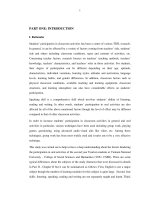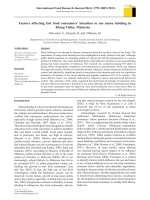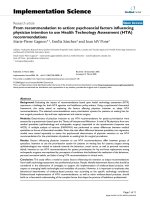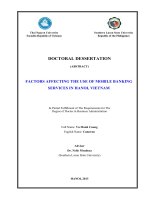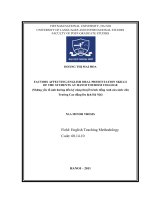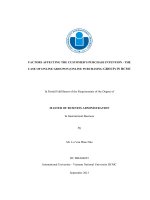Critical factors affecting the customers intention to use e retailing
Bạn đang xem bản rút gọn của tài liệu. Xem và tải ngay bản đầy đủ của tài liệu tại đây (917.99 KB, 65 trang )
UNIVERSITY OF ECONOMICS HO CHI MINH CITY
International School of Business
-------------------------
Dang Duy Thanh
CRITICAL FACTORS AFFECTING THE CUSTOMERS’
INTENTION TO USE E-RETAILING
MASTER OF BUSINESS (Honours)
Ho Chi Minh City – Year 2014
UNIVERSITY OF ECONOMICS HO CHI MINH CITY
International School of Business
-------------------------
Dang Duy Thanh
CRITICAL FACTORS AFFECTING THE CUSTOMERS’
INTENTION TO USE E-RETAILING
ID: 22120030
MASTER OF BUSINESS (Honours)
SUPERVISOR: Dr. Cao Hao Thi
Ho Chi Minh City – Year 2014
ACKNOWLEDGEMENT
I would like to express my deep gratitude to everyone who helped and guided me through the
entire MBA program.
Foremost, I would like to express my sincere thanks to my supervisor Dr. Cao Hao Thi for the
continuous support for my MBA thesis and research, for his patience, motivation, enthusiasm,
and immense knowledge. His guidance helped me in all the time of research and writing of this
thesis. I could not have imagined having a better advisor and mentor for my MBA study.
I am grateful to thank Prof. Nguyen Dinh Tho and the International School of business (ISB)
not only because they had built this extremely practical and helpful program but also the way
Prof. Tho and ISB supported me during my MBA time.
I also would like to extent my appreciation to my dear classmates. Together we have had lots of
wonderful new experiences in learning and building social network.
Last but not least, I would like to express my special gratitude to my family for their endless
encouragement and support through my life.
i
Abstract
During the last decade of the 21st century, internet shopping had grown in a surprising speed.
With the fast development in internet and technology, people are no longer need to go out for
their shopping since they can use e-retailing for almost everything they need. Although eshopping has its huge potential to even replace the traditional way of shopping, it has its own
problem. It is when people only use website for reference, and then they come directly to the
physical store to pick up their items.
This research is conducted to find out the critical factors that can measure the customers’
intention to use e-retailing. From several studies about this topic, especially the theory of
reasoned action (TRA), there are four factors may affect to the customer’s intention. They are
trust, subjective norm, website quality and perceived risk in using credit card.
In order to conduct the research, a sample size of 150 questionnaire about clothing products are
collected with respondents are office employees in Ho Chi Minh city. Then, the data are
analyzed by reliability test, EFA and multiple regression analysis.
Result of the thesis shows that the customers’ intention to use e-retailing is impacted only by
trust and subjective norm. Therefore, it is suggested that owners of the business should try to
gain trust of their customers and encourage people to shop by groups.
Since this research only focused in fashion products in Ho Chi Minh city, furthers studies in
this field should be conducted for other types of products and in other provinces in Vietnam to
find out the general model for Vietnamese e-retailing.
Keywords: intention to use, TRA, e-retailing
ii
Table of content
Acknowledgement
i
Abstract
ii
Chapter 1_INTRODUCTION
1
1.1 Research background
1
1.2 Problem statement
2
1.3 Research objectives
3
1.4 Research questions
3
1.5 Research scope
3
1.6 Research significant
4
1.7 Research structure
4
Chapter 2_LITERATURE REVIEW
6
2.1 E-retailing
6
2.2 Customers’ intention to use e-retailing
7
2.3 Factors impact to the customers’ intention to use e-retailing
12
2.3.1 Research model
12
2.3.2 Trust
13
2.3.3 Subjective norm
14
2.3.4 Website quality
15
2.3.5 Perceived risk in using credit card
16
2.3.6 Demographic variables
16
Chapter 3_ RESEARCH METHODOLOGY
18
3.1 Research process
18
3.2 Measurement scale of factors
19
3.3 Pilot test
21
3.4 Data collection
21
3.5 Data analysis method
21
iii
Chapter 4_ DATA ANALYSIS
23
4.1 Descriptive statistics
23
4.2 Reliability test
24
4.3 Validity test
26
4.4 Multiple regression analysis
29
4.4.1 Regression results
29
4.4.2 Tests of the regression assumptions
30
4.4.3 Hypotheses testing
32
4.4.4 ANOVA analysis
33
4.4.5 Regression analysis summary
34
Chapter 5_ CONCLUSION AND RECOMMENDATIONS
36
5.1 Research findings
36
5.2 Managerial implications
38
5.3 Limitations and further researches
39
REFERENCES
APPENDICES
iv
LIST OF FIGURES
Figure 2.1 The theory of reasoned action (TRA)
9
Figure 2.2 Research model
12
Figure 3.1 Research process
18
Figure 4.1 Scatter plot of residuals
30
Figure 4.2 Histogram of regression standardized residuals
31
Figure 4.3 Normal P-P plot of regression standardized residuals
31
Figure 4.4 Result of testing model
35
LIST OF TABLES
Table 2.1 Dimensions of e-retailing quality
11
Table 3.1 Scale items of factors
20
Table 4.1 Distribution of survey respondents
24
Table 4.2 Results of reliability test
24
Table 4.3 KMO and Bartlett's Test
27
Table 4.3 Total variance matrix
27
Table 4.5 EFA result – Rotated component matrix
28
Table 4.6 Coefficient table of multiple regression
29
Table 4.7 Model summary of regression analysis
29
Table 4.8 ANOVA result in regression analysis
32
Table 4.9 Results of multiple regression analysis
33
Table 4.10 ANOVA for Gender
33
Table 4.11 ANOVA for Age
34
Table 4.12 ANOVA for Income
34
v
ABBPREVIATION
ANOVA
Analysis of variance
COD
Cash on delivery
EFA
Exploratory factor analysis
IRQ
Internet retailing quality
KMO
Kaiser-Mayer-Olkin
TRA
Theory of reasoned action
vi
Chapter 1
INTRODUCTION
1.1 Research background
E-retailing, also known as online shopping, internet shopping or e-shopping, can be
explained as an electronic commerce when buyers and sellers virtually meet others through a
web browser. Unlike traditional shops that require physical locations, physical security services
and specific timeframes to operate, internet shops need none of those requirements. Customers
can access to the shop from anywhere and anytime they like as long as they have internet
connection and an appropriate device like a computer, a tablet or a smartphone. Since people
are more and more busy with their job and internet has been widely and easily accessible, eretailing has “redefined business and customer relationships, business processes, even
sometimes restructuring the whole industry by providing new distribution channel, new
delivery methods, new payment methods and new medium for communication” (Dogerlioglu
and Cosgun, 2012). People had forecasted that in 2014 US e-retailing business can earn up to
$291 billion dollars in sale (Trends & Data - Internet Retailer).
With the tremendous opportunity to grow and a very promising market to exploit, eretailing has been attracting many scholars and experts to make researches in order to become
successful in this new method of selling products. As the results of that, many factors had been
explored to contribute to a successful online business. In 2009, Liao and Shi found that in Hong
Kong market, where people tend to shop in groups, social influence should be a big factor that
influence on the shopping behavior. Even internet retailing does not require people to go out
for shopping, owners of the e-retailing business still need to think of ways like spreading
information as wide as possible, focusing on group buying, encouraging group-buying
activities, etc.
Another research about internet shopping in Malaysia showed that one of the most
important factors that lead to the customers’ intention is their attitude towards e-retailing (Ting
& Lim, 2012). In that research, the authors also highlighted the easiness, usefulness and
1
effortless when customers interact with the web pages can create the favorable shopping
intention. Besides the attitude towards e-retailing, Gefen, Karahanna and Straub (2003) added
that customers’ trust played a significant role in increasing customers’ intention to shop online.
They also proved that trust in e-vendor can be gained when people know that shop owners earn
nothing more by cheating, a shop is safe to make transaction and the website is optimized to be
friendly and easy to use.
As mentioned above, since e-retailing has been developed with a rocket speed, there are
thousands of researches have been made only for gaining customers’ intention towards internet
shopping. However, not many of them were made specifically for Vietnamese market.
Therefore, it is an interesting topic to discover and study.
1.2 Problem statement
In Vietnam, although traditional retailing is still playing a significant role, internet
shopping has been developed so rapidly and become more important. According to Phan
(2013), 36% of Vietnamese people are using internet and they generated a 700 million US
dollars in revenue for e-retailing. Although e-shopping only accounted for 0.3 to 0.5% of the
total retailing revenue in Vietnam (according to Green Global, 2013), it can increase up to 2
times - 1.3 billion US dollars in 2015 (according to the Ministry of Industry and Trade).
However, internet shopping has its own problem. It is because many of the internet users only
go to the websites to find information, the price and comments about the products but they
hesitate to make the paying transaction or products reservation (Ting & Lim, 2012).
Vietnamese customers would rather go direct to the shop and buy the things they saw on web.
As the result of that, e-shopping as they know is nothing but an advertising or marketing
channel.
Nguyen (cited by vnexpress.net, 2014), a lecturer in Electronic Commerce faculty,
University of Commerce stated that:
In Vietnam, most of Vietnamese businesses are small or medium businesses. They are companies that
can only afford small investments but want to try electronic commerce in the belief that they can be fast
2
successful in this field. However, I fear that doing business like that will lead to failure for most
companies. Investing in e-retailing requires much more money than people think. Moreover, life in
Vietnam is not that industrialized that people have to go online for shopping.
Therefore, Vietnamese e-retailing market is very challenging to small and medium
businesses but it is also very promising with the prospect of fast developing and huge revenue
it can generate. The problem is how an internet based retailing business can connect to the end
clients and persuade them to make transactions through their sites. It is why the research was
conducted, to find and understand what significant factors affecting the intention of people to
use e-retailing.
1.3 Research objectives
As discussed in Section 1.1, e-retailing business is not only very promising in Vietnam but
also very challenging. In order to be successful in this field, people firstly need to discover
what factors can drive the shopping intention of clients. Therefore, this research aims to:
-
Identify critical factors affecting customers’ intention to use e-retailing
-
Identify the level in which each factors affecting customers’ intention to use e
retailing
1.4 Research questions
There are two questions to be answered to solve the problem identified in Section 1.2:
-
What are critical factors affecting customers’ intention to use e-retailing?
-
What is the level of impact of each factors affecting customers’ intention to use eretailing?
1.5 Research scope
First of all, surveys questionnaire are collected only in Ho Chi Minh city – this is the most
crowded city in the country and also known as the biggest economic center in Vietnam.
Second, only clothing products were researched. It is because clothing products are easy to
store and deliver (compare with grocery or electronic products). Besides, clothing products are
fast to produce and people tend to change their clothes so many times during a year. Especially,
3
clothing products are manufactured by seasons, even when a cloth is quite new, people still
change it to others when season changes. Finally, the research focus in office employees since
they spend lots of their time sitting in front of a computer, have the opportunity to use internet
almost daily and have good knowledge about computer or internet activities.
1.6 Research significance
Because of the development of e-retailing, customers now have more choices to buy their
needs. They can choose either going to the shop to pick up the products when they have time or
sitting in front of an internet devices and performing a transaction to get their products. Eretailing therefore brings benefits not only to consumers but also to sellers. People can shop
whenever they like and sellers can sell almost 24/7.
This research aims to discover the significant factors affecting customers’ intention to use
e-retailing in Vietnamese context. Results of the thesis may contribute to the academic
knowledge in terms of Vietnam e-retailing market and Vietnamese consumers’ decision
factors. It can help business to understand what affects to customers’ intention when they try
their services. Therefore, they can define a better strategy and customize their service to have
better e-shopping experiences to attract to more customers. For a general picture, the research
may contribute, to some extent, to develop the Vietnamese e-retailing market in the future.
1.7 Research structure
This research consists of five chapters. First chapter is the introduction that presented the
overview about the topic, the purpose of the research and the approached way to solve the
research’s problem. Next chapter is the literature review where prior studies about internet
shopping had been reviewed in order to propose the conceptual model and hypotheses. Chapter
3 is about the research methodology in which the research process is discussed. Then, Chapter
4 about data analysis illustrates the testing of survey data. In Chapter 4 also, results of the
proposed model are presented. Final chapter is about conclusion and recommendations where
research findings and managerial implication are discussed. In this chapter, the limitations of
4
the research are mentioned in order to provide the directions for further researches about
customers’ intention to use e-retailing the future.
5
Chapter 2
LITERATURE REVIEW
In this chapter, previous researches are reviewed in order to derive an empirical research
model. There are three main parts in this chapter, including the definition of e-retailing,
customer’s intention to use e-retailing and factors that affecting the customers’ intention to use
e-retailing.
2.1 E-retailing
Blooming since the last decade of the 20th century, internet had been developed by an
exponential rate and its impact had made significant changes in almost all industries. One of
the most affected is the retailing business. Traditional method of selling products by displaying
all items in a physical store and waiting for customers to come and pick them up is endangered
since many customers prefer to sit in front of their electronic devices and buy the products they
need right on their devices over the internet. In other words, many people would rather use eretailing than travel to the real shop. Therefore, this kind of shopping is attracting not only
buyers and sellers but also researchers because of its convenience, speed, 24/7 services, full of
products’ detail and reviews. By definition, e-retailing, or internet shopping, means that buying
and selling processes are all made through internet. Although many of us do not have the habit
of buying online, the reality is that we do spend lots of time searching for products’ information
and specifications on the internet. According to ReachLocal (2012), 21% of the time people
spending on the internet is for searching only and 61% of internet users research for their
products online (Interconnected World: Shopping and Personal Finance, 2012).
Andam (2003) has defined e-retailing as a form of e-commerce - “a range of online
business activities for products and services”. E-retailing can be understand as a B2C ecommerce, a commerce between companies or shops and customers, it involves customers’
purchasing both kinds of goods (physical and informational) and receiving them over an
electronic network (Andam, 2003).
6
Back to the mid of 1990s, the founding of Amazon and eBay can be named the origin of eretailing. The early success of the two companies signaled the huge changes could happen in
the way people run their business. Since buyers know that they can save lots of time traveling
to see and buy a product, they can stay at home, use some clicks and have products delivered to
their home the next day or two. That was just so simple and convenient. Consumers using
internet shopping not only save time but they are also allowed to save cost since they have
chances of choosing the most competitive products among internet sellers. Not long time after
the Amazon and eBay succeeded, many internet based retailers were founded and then they
completely redefine the retailing industry. According to Deloitte, e-commerce accounted for a
significant share of total retail revenue for the top 50 e-retailers in fiscal year 2012, accounting
for nearly one-third of company sales on average.
Not only brings huge benefits to consumers, but e-retailing also makes significant
improvement to the resellers. Andam (2003) stated that e-retailing can reduce the market
barriers since the cost of setting up and operating a website is much cheaper than building a
traditional “brick and mortar” shop. He also said that for a country with robust internet
population, delivering informational goods (electronic books, digitized contents or software)
becomes significantly potential.
2.2 Customers’ intention to use e-retailing
Defined by Ajzen (1991, p.181), an intention is ‘‘indicators of how hard people are willing
to try, of how much of an effort they are planning to exert”. In another study, intention was
referred to” the individual’s assessment of the subjective probability that people will perform a
particular behavior in the future”(Söderlund & Öhman, 2003, p.54). In e-retailing context, Bai,
Law and Wen (2008) stated that purchasing intention is a primary result of pre-purchase
satisfaction. Chen, Hsu and Lin (2010) even confirmed that the online shopping intention is the
significant predictor of actual buying behavior. Applying to this research, customers’ intention
to use e-retailing is defined as the expectation or intent of customers to perform the online
purchasing in the future.
7
Theory of reasoned action (TRA) is one of the famous models that widely used to predict
the behaviors of customers based on their behavioral intention. Derived from numerous
researches and theories about customers’ attitude, TRA model was proposed by Ajzen and
Fishbein (1975 & 1980). It suggests that the immediate antecedent of a behavior is the intention
to perform the behavior in question (Fishbein and Ajzen, 1975). It can be seen that the stronger
the intention people want to try something, the higher the possibility that they may actually do
it. In the context of this research, customer’s intention can be defined as the intent or
expectation of a customer to purchase products via internet channels. There are three key
factors to form the construct, they are two independent factors that are used to define the
behavioral intention. First factor is person’s attitude and the second is subjective norm.
-
Person’s attitude. Generally, attitudes can be understood as the beliefs about the
results of performing an behaviors and the evaluation of those expected outcomes.
-
Subjective norm. In a simple form, subjective norm can be defined as the opinion
of one person on how he/she thinks others should view them if they perform a behavior.
The summary of TRA model can be expressed as the Figure 2.1:
Alternatively, in a simple form, TRA can be written as a formula:
BI = (AB) W1 + (SN) W2
BI: Behavioral intention
AB: Attitude toward performing a behavior
SN: Subjective norm related to performing a behavior
W: empirically derived weights
(Dillard & Pfau, 2002 )
8
Figure 2.1 The theory of reasoned action
(Vallerand et al., 1992)
Because of the possibility to predict the people intention towards a behavior, TRA had
been used in a variety of contexts and industries. For example, Vallerand, Deshaies, Cuerrier,
Pelletier and Mongeau (1992) had used TRA to research about the moral behavior and they
found that both attitude and subjective norm positively supported the model. Particularly,
attitude did prove to be more important to predict a behavior than subjective norm.
Alternatively, another research made in Thailand by Chuchinprakarn (n.d.) also found that
attitude and subjective norm did influence the customers’ intention to shop on-line.
In this thesis, in addition to the TRA model, other models and researches are included to
help explaining the customer’s intention. In details, internet retailing quality (IRQ) and
customers’ perceived risk in using credit card are added to form the research model.
As defined in Section 2.1, e-retailing is a new way of purchasing products when consumers
only need an electronic device and internet connectivity to perform a transaction. Since internet
9
shopping is also a service, the concept of quality applied in this context is similar to
conventional service quality. As such, e-retailing quality should incorporate all of the
functional aspects of the service process as well as the technical ones of the service outcome
(Gronroos et al., 2000; Collier and Bienstock, 2006). According to Parasuraman et al. (2005,
p.217), internet retailing can be defined as “the extent to which a web site facilitates efficient
and effective shopping, purchasing and delivery”. In other to measure the e-retailing quality,
there are number of scales had been created, some of them are summarized in Table 2.1.
As seen from the Table 2.1, one of the most important dimensions to measure e-retailing
quality is the website quality. Website quality is a significant factor in internet shopping since
“the customers’ perceptions of website quality positively impact their intentions to use a site
and directly affect purchase intentions” (Chang, Kuo, Hsu & Cheng, 2014, p.256). In a simple
way, website quality is defined by its content and user interface. A high quality website needs
to provide relevant and useful content along with its good and easy user interface. It is so
simple since almost all actions customers have to make to perform a purchase are placing on a
web browser. Therefore, in this research, instead of using IRQ in general, website quality will
be measured to examine the customers’ intention to use e-retailing.
Perceived risk is defined as uncertainties of possible negative consequences of using a
product or service (Chang, Kuo, Hsu & Cheng, 2014). In this research, perceived risk in using
credit card refers to the uncertainties of people that they may lose money when purchasing
products online. The financial loss due to credit card fraud is a primary concerns among online
customers (Dai, Forsythe & Kwon, 2014).
10
Table 2.1. Dimensions of e-retailing quality
Authors (scale)
Barnes and Vidgen,
2001 (WebQual)
Dimensions of quality
Usability, information quality, interaction quality
Ease of use, privacy, design, information accuracy,
Collier and Bienstock,
functionality, order condition, timeliness, order
2006
accuracy, interactive fairness, outcome fairness,
procedural fairness
Francis and White, 2002 Web site, transaction system, delivery, customer
(PIRQUAL)
Janda et al. , 2002
(IRSQ)
Janda et al. , 2002
(IRSQ)
service, security
Performance, access, security, sensation, information
Performance, access, security, sensation, information
Information fit to task, interactivity, trust, response
Loiacono et al. , 2002
(WebQual)
time, ease of understanding, intuitive operations,
visual appeal, innovativeness, flow-emotional
appeal, consistent image, online completeness, better
than alternative channel
Long and McMellon,
Tangibility, assurance, reliability, purchasing
2004
process, responsiveness
Parasuraman et al. ,
2005 (E-S-QUAL)
Ribbinket al. , 2004
Srinivasan et al. , 2002
Efficiency, system availability, fulfilment, privacy
Ease of use, e-scape, responsiveness, customization
Customization, contact interactivity, cultivation,
care, community, choice, convenience, character
Wolfinbarger and Gilly,
Web site design, fulfilment/reliability,
2003 (eTailQ)
security/privacy, customer service
Yoo and Donthu, 2001
Ease of use, aesthetic design, processing speed,
(SITEQUAL)
security
(Francis, 2007)
11
2.3 Factors impact to the customers’ intention to use e-retailing
2.3.1 Research model
Based on the TRA model and other researches that explained the customers’ intention
toward a behavior, the research model is proposed in Figure 2.2. This model contains four
independent factors, including trust, subjective norm, website quality and perceived risk in
using credit card, that affecting the intention of customers to purchase product online. In
addition, three more demographic variables were used to test whether the characteristic of
customers have any significant difference on their intention.
Gender
Age
Income
Trust
H1+
Subjective Norm
H5
H2+
Customers’ Intention to
use e-retailing
H3+
Website Quality
H4Perceived Risk in
Using Credit Card
Figure 2.2 Research model
Hypothesis 1: Trust has a positive effect on the customer's intention to use e-retailing.
Hypothesis 2: Subjective norm has a positive effect on the customer's intention to use eretailing.
Hypothesis 3: Website quality has a positive effect on the customer's intention use e-retailing.
Hypothesis 4: Perceived risk in using credit card has a negative effect on the customer's use eretailing.
12
Hypothesis 5: Characteristics of customers have significant difference on their intention use eretailing.
2.3.2 Trust
According to the TRA model (Ajzen & Fishbein, 1980; Fishbein & Ajzen, 1975), the best
predictor of a future behavior could be the behavioral intention. One of the influences on the
intention is the person’s attitude toward performing the behavior. Generally, attitudes can be
understood as the beliefs about the results of performing a behavior and the evaluation of those
expected outcomes. It “represents the person's general feeling of favorableness or
unfavorableness for the behavior in question" (Ajzen & Fishbein, 1980). So the more
positive people believe in the behavior, the more likely they intend to perform it.
However, since personal attitude is a very wide range to study, the author had narrowed it
down by using only one of its components. So, trust was considered as one of the best choices.
Recently, trust had been widely discussed as a key factor for a successful online business. In
term of a business, trust is defined as “the consumers’ belief and expectation that e-sellers are
reliable and will perform their obligations faithfully” (Chuchinprakarn, n.d.). Trust is an
important factor affecting consumers’ behavior and it may contribute to the success of
technologies adoption such as e-commerce (Chen & Barnes, 2007; Holsapple & Sasidharan,
2005; Goles et al., 2009; Yang et al., 2003). It can be seen that buyers are more likely to make
transactions on the internet if they know that sellers are trustworthy and reliable. Unlike
physical store that people can come and try the items, online shops have almost no thing to
guarantee customers that their items are exactly what people can see in their websites. Because
of that, customers’ trust even plays a more critical role to the intention of purchasing online
then buying by traditional method. According to a report from Yahoo Finance in 2012, the top
three counterfeited products in America are all related to clothing items, i.e. wearing apparels
and accessories, watches and jewelries, handbags and wallets. It is said that one of the source to
deliver fake products is the online shop since people can not touch the real items but only read
their info on the websites. Although the availability and easiness of buying a product is
13
changing since the booming of internet usage, there is an old-fashioned value that every
business needs to maintain – it’s customer’s trust.
Since trust could significantly effects on e-retailing, first hypothesis is proposed as:
H1: Trust has a positive effect on the customer's intention to use e-retailing.
2.3.3 Subjective norm
In a simple form, subjective norm is the opinion of one person on how he/she thinks others
should view them if they perform a behavior. In a research, they define subjective norm as a
social factor referring to the perceived social pressure to perform or not to perform the behavior
(Ajzen and Madden, 1986). Normally, a social circle of a person includes his or her peers,
which constitute siblings, friends and acquaintances (Pilgrim & Lawrence, 2001).
According to Liao and Shi (2009), the influence from a social group should not be ignored
since the surrounding may highly affects to individuals to perform a behavior. Especially in
Vietnam where people are more collectivistic than individualistic, social norm may even has a
more important role impacted to the intention of people. Clasen and Brown (1985) stated that
an individual who belongs to a group may adapt his habits according to that group, he then
complies with the dominant traits of that group to form his own trait, intentionally or
unintentionally.
Therefore, it is a reality since we know sometimes people are very positively affected by
subjective norm. They may not be favorable to a behavior or consequence but they do want to
perform it because they believe in their referents. It is the time when people feel motivated to
perform a behavior. According to Davis and Vekatesh (2000), working environment positively
affects to the individual behavioral intention. Lee, Cheung, Sia and Lim (2006) also found that
the positive informational social influence could enhance the relationships between customers’
attitude about internet shopping and their intention to shop.
In this research, the social norm that affects the customers’ intention to use e-retailing is
referred to the customers’ co-workers and friends. People working in the office meet their peers
very frequently, almost day-to-day basis so they are likely to be more up to date with new
14
trends in fashion products. As discussed earlier in this section, Vietnamese people are
collectivistic, like many other Asian countries, so they have a tendency to follow others. An
office employee may feel very isolated if he or she can’t catch up with the new trends in his/her
office.
At such, social influence is believed to have significant impact to the customers’ intention
to shop online. Therefore, the second hypothesis is proposed as:
H2: Subjective norm has a positive effect on the customer's intention to use e-retailing.
2.3.4 Website quality
Pinho et al. (2011) was successful to discover the influence of website quality
characteristics on intention of users in applying online services. They found that factors
including research facility, provides detailed information, privacy and security, interaction
facilities and contacts, speed and facility of access, availability of relevant downloads, reliable
and up-to-date information are the most important qualifications of a website. The research
results presented that website quality increases intention of the users.
In another research of Bai, Law & Wen (2008) about the direct effect of website quality on
customer satisfaction and purchase intention in China, they concluded that customer
satisfaction and purchase intention are directly influenced by website quality. Jeong, Fiore,
Niehm, and Lorenz (2009) found that rich website design elements can enhance the users’
interest and experiences, which in turn increased their intention to purchase.
Wolfinbarger and Gilly (2003) stated that when customers interact with an online store they
prefer to do their shopping through a technical interface and do not need the existence of any
employees. Therefore, the design of the website, which acts as the interface, would play an
important role in influencing customer satisfaction.
Therefore, hypothesis three is proposed as:
H3: Website quality has a positive effect on the customer's intention use e-retailing.
15
2.3.5 Perceived risk in using credit card
Perceived risk in using credit card is the uncertainties of financial loss when using credit
card for online purchasing. Consumers are worried to give their personal information
particularly data on financial status and credit facilities to the internet because of the fact that
there is no direct eye-contact and thus, consumers are concern about unauthorized use of their
private information (Grabner-Kraeuter & Faullant, 2008).
Chakravorti (2003) stated that people are hesitate to make their online purchasing by credit
card since they are afraid that they cannot afford their payment when the card is on due date. It
is a real risk because people may over consume their money without having control on their
balances. It can lead to financial debt in the worst case when consumers have to pay additional
fee and interest. In a research conducted by Salam, Rao and Pegels (2003), they found that
consumers will highly stop making transactions over internet if for some reason, the potential
loss of finance is too high. They stated that “the consumer’s perception of risk associated with
the transaction will tend to predominate in his/her decision to engage in a transaction”.
At the result of that, the hypothesis four is proposed as:
H4: Perceived risk in using credit card has a negative effect on the customer's use e-retailing.
2.3.6 Demographic variables
In testing the customers’ intention use e-retailing, this research also included some
demographic variables. The purpose is to know whether characteristics of consumers have any
significant effect on their intention to perform the internet shopping. Three variables are chosen
to investigate, they are gender, income and age.
In 2002, Burke (as cited in Suki, 2011) stated that demographics (gender, age, education)
are key moderators in the online shopping environment. Whitely (1997) also confirmed that
males are more positive and less anxious about technology innovations, which are very likely
to happen in the world of online retailing. As growing older, people are less likely to access
online information and using websites for shopping (Suki, 2011).
Therefore, the fifth hypothesis is proposed as:
16
H5: Characteristics of customers have significant difference on their intention use e-retailing.
In summary, this chapter is written to review researches conducted in the past to find the
model that can predict the customers’ intention to use e-retailing. By revising TRA model and
other studies, four factors were chosen to form the research model. They are trust, subjective
norm, website quality and perceived risk in using credit card. From the four factors, only
perceived risk in using credit card has the negative impact on the customers’ intention.
In addition, three demographic variables were added to the model to find out if gender, age
or income affect to the customers when they choose to shop online.
17
